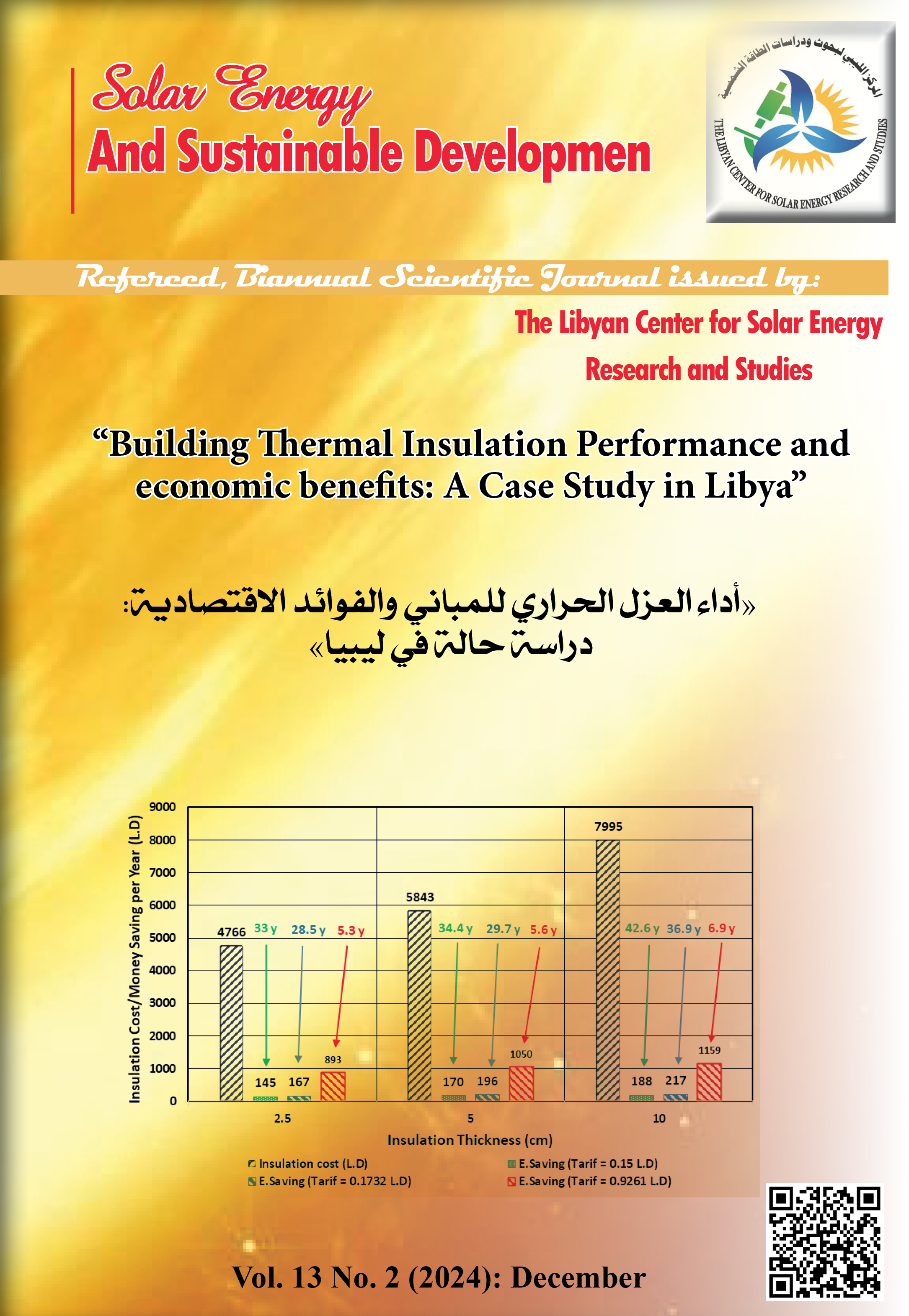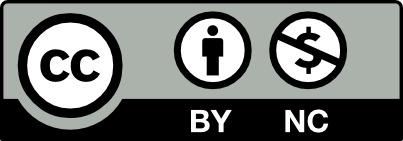Building Thermal Insulation Performance and economic benefits:
A Case Study in Libya
DOI:
https://doi.org/10.51646/jsesd.v13i2.197Keywords:
Energy Plus, Polystyrene, insulation thickness, insulation density.Abstract
Three different insulating scenarios were investigated using Energy-plus software, to study the effect of using expanded polystyrene boards on building energy consumption at the Libyan Center for Solar Energy Research and Studies. The three insulation scenarios with different polystyrene insulation thicknesses and densities were investigated. Polystyrene total cost, Payback period, total and net money saving using insulation, as well as the percentage gain were calculated for each case in the three investigated scenarios for 50 years. The most money saving scenarios after 50 years is by insulating the building roof and external walls with an average insulation thickness of 7 cm, reaching about 78000 L.D and a tariff of 0.9261 L.D /kWh. While the least money saving is the roof scenario with an insulation thickness of 2.5 cm, reaching more than 29000 L.D and the same tariff. The highest percentage gain values are 76 %, 103 % and1090 % at the roof scenario, 2.5 cm insulation thickness and energy tariffs of 0.15 L.D /kWh, 0.1732 L.D/kWh and 0.9261 L.D/kWh, respectively. While the lowest percentage gain values are about 17.5 %, 35.7 % and 725 % at the wall scenario 10 cm insulation thickness and energy tariffs of 0.15 L.D/kWh, 0.1732 L.D/kWh and 0.9261 L.D/kWh, respectively. the payback period of total insulation cost is significantly dependent on insulation thickness and energy tariff. These results show that low energy tariff (current energy tariff) values economically are not cost effective regarding the payback period. Consequently, prices do not motivate residents to save energy with the use of thermal insulation unless actual energy prices are considered.
Downloads
Metrics
References
GECOL, “General Electric Company of Libya (Statistics of 2012),” Tripoli, Libya, 2016. [Online]. Available: https://web.archive.org/web/20150924021233/http://www.gecol.ly/resources/documents/reports/static_ar_2012.pdf.
M. Abdunnabi, I. H. Tawil, M. Benabeid, M. A. Elhaj, and F. Mohamed, “Design of Solar Powered Space Heating and Domestic Hot Water System for Libyan Common House,” in 2021 12th International Renewable Energy Congress (IREC), 2021, pp. 1–6, doi: 10.1109/IREC52758.2021.9624800. DOI: https://doi.org/10.1109/IREC52758.2021.9624800
A. Bolattürk, “Determination of optimum insulation thickness for building walls with respect to various fuels and climate zones in Turkey,” Appl. Therm. Eng., vol. 26, no. 11–12, pp. 1301–1309, 2006. DOI: https://doi.org/10.1016/j.applthermaleng.2005.10.019
A. Bolattürk, “Optimum insulation thicknesses for building walls with respect to cooling and heating degree-hours in the warmest zone of Turkey,” Build. Environ., vol. 43, no. 6, pp. 1055–1064, 2008, doi: https://doi.org/10.1016/j.buildenv.2007.02.014. DOI: https://doi.org/10.1016/j.buildenv.2007.02.014
K. Alshaibani, F. Almaziad, M. Y. Numan, and I. Almofeez, “Glazing Openings and Thermal Insulation in Saudi Arabia.” Mar. 29, 2015. DOI: https://doi.org/10.4197/Env.8.4
S. K. Alghoul, A. O. Gwesha, and A. M. Naas, “The effect of electricity price on saving energy transmitted from external building walls,” Energy Res. J, vol. 7, pp. 1–9, 2016. DOI: https://doi.org/10.3844/erjsp.2016.1.9
E. Amiri Rad and E. Fallahi, “Optimizing the insulation thickness of external wall by a novel 3E (energy, environmental, economic) method,” Constr. Build. Mater., vol. 205, pp. 196–212, 2019, doi: https://doi.org/10.1016/j.conbuildmat.2019.02.006. DOI: https://doi.org/10.1016/j.conbuildmat.2019.02.006
M. Albizanti, A. Shinshin, A. Zgalei, and S. Alghoul, “The impact of the costs associated with adding thermal insulation to the exterior walls of buildings on optimal thickness and payback period,” J. Sol. Energy Sustain. Dev., vol. 11, no. 1, pp. 24–33, 2022.
S. Dardouri, S. Mankai, M. M. Almoneef, M. Mbarek, and J. Sghaier, “Energy performance based optimization of building envelope containing PCM combined with insulation considering various configurations,” Energy Reports, vol. 10, pp. 895–909, 2023, doi: https://doi.org/10.1016/j.egyr.2023.07.050. DOI: https://doi.org/10.1016/j.egyr.2023.07.050
Q. Al-Yasiri and M. Szabó, “Building envelope-combined phase change material and thermal insulation for energy-effective buildings during harsh summer: Simulation-based analysis,” Energy Sustain. Dev., vol. 72, pp. 326–339, 2023, doi: https://doi.org/10.1016/j.esd.2023.01.003. DOI: https://doi.org/10.1016/j.esd.2023.01.003
N. A. Aboudh, “Integration of photovoltaic cells in building shading devices: Enhancing energy efficiency and indoor environment in administrative building,” J. Sol. Energy Sustain. Dev., vol. 13, no. 2, pp. 83–101, 2024. DOI: https://doi.org/10.51646/jsesd.v13i2.230
A. O. S. A. F. M. Alghnain, I. A. Bernaz, “Power consumption analysis of the engineering affairs building of the Libyan Center for Solar Energy Research and Studies,” Sol. Energy Sustain. Dev. J., vol. 11, no. 1, pp. 34–46, 2022.
The National Renewable Energy Laboratory (NREL, “EnergyPlus.” U.S. Department of Energy’s (DOE) Building Technologies Office (BTO, 2022, [Online]. Available: https://energyplus.net/.
The National Renewable Energy Laboratory (NREL), “Welcome to OpenStudio® SDK User Documentation,” 2024. https://nrel.github.io/OpenStudio-user-documentation/.
Council of Ministers, “Resolution No. 647 of 20220 AD to determine the prices of selling electricity,” 2022. .
D. P. P. Meddage, A. Chadee, M. T. R. Jayasinghe, and U. Rathnayake, “Exploring the applicability of expanded polystyrene (EPS) based concrete panels as roof slab insulation in the tropics,” Case Stud. Constr. Mater., vol. 17, p. e01361, 2022, doi: https://doi.org/10.1016/j.cscm.2022.e01361. DOI: https://doi.org/10.1016/j.cscm.2022.e01361
N. Llantoy, M. Chàfer, and L. F. Cabeza, “A comparative life cycle assessment (LCA) of different insulation materials for buildings in the continental Mediterranean climate,” Energy Build., vol. 225, p. 110323, 2020, doi: https://doi.org/10.1016/j.enbuild.2020.110323. DOI: https://doi.org/10.1016/j.enbuild.2020.110323
M. Mequignon and H. A. Haddou, “Impact of the lifespan of building external walls on depletion of natural resources,” IFAC-PapersOnLine, vol. 48, no. 3, pp. 351–356, 2015. DOI: https://doi.org/10.1016/j.ifacol.2015.06.106

Downloads
Published
How to Cite
Issue
Section
License
Copyright (c) 2024 Solar Energy and Sustainable Development Journal

This work is licensed under a Creative Commons Attribution-NonCommercial 4.0 International License.













